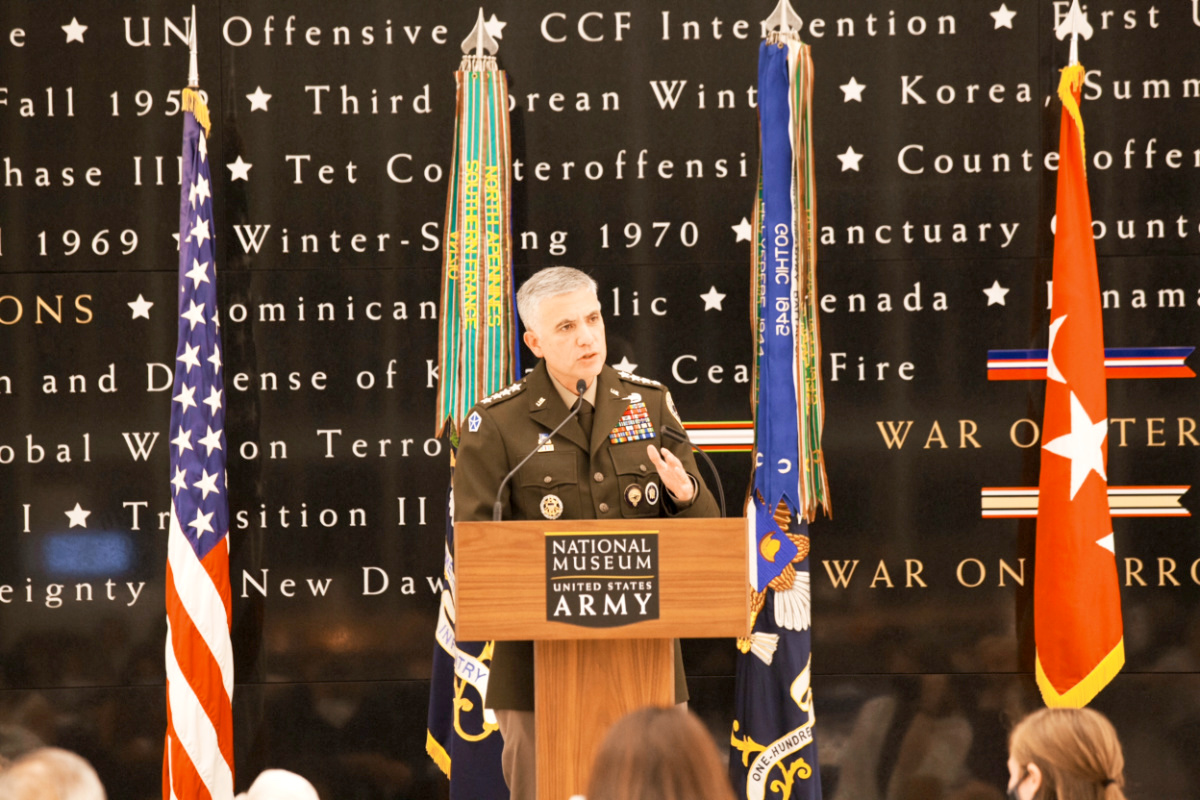
Gen. Paul Nakasone served as the keynote speaker of the NVN Celebration Dinner. (Photo: Courtesy of NVN)By P.C. Staff
Nearly 10 years after the Congressional Gold Medal recognition that was bestowed upon Nisei soldiers who served in the U.S. Armed Forces during World War II, that generation of Japanese American servicemen was again honored, this time in conjunction with the recently reopened National Museum of the United States Army, located at Fort Belvoir, Va.
After a pandemic-induced delay, the Nisei Soldier Experience exhibition at the NMUSA officially opened with a three-day gala that began on Sept. 2.
According to National Veterans Network Executive Director Christine Sato-Yamazaki, whose organization has worked closely with the NMUSA on the Nisei Soldier Experience since 2017 to make and execute plans, as well as gather artifacts for the display, it was a long time coming.
“We were supposed to have the event in April 2020. It was actually right before the museum was supposed to open to the public. Of course, that’s when the pandemic all started. So, we had to cancel that event,” Sato-Yamazaki said.
The NMUSA itself had originally been slated to officially open on Veterans Day 2020, which it did, only to be promptly shut down due to the spread of SARS-CoV-2 by Dec. 14, not reopening until Flag Day, June 14, 2021, which was also the Army’s 246th birthday.
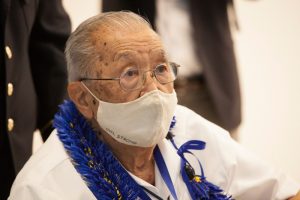
Ralph Matsumoto (Photo: Courtesy of NVN)
Fast-forwarding to September, the Nisei Soldier Experience finally opened. In attendance were guests of honor Helen and Charles Moriyama of Honolulu, and Amy and Ralph Matsumoto of Paramount, Calif. Charles Moriyama, 96, and Ralph Matsumoto, 100, both served in the Military Intelligence Service during WWII.
Charles Moriyama, who retired from the Army as a colonel, was quoted in an NVN news release: “My wife, Helen, and I made the decision in 2019 that we would visit the museum when it opened. Nothing could have stopped us from coming for this historic event. I wish more of my fellow Nisei veterans were still here to see this exhibit that honors the sacrifice, service and honor of our units during WWII. I thank everyone who worked so hard for this exhibit, especially the National Veterans Network.”
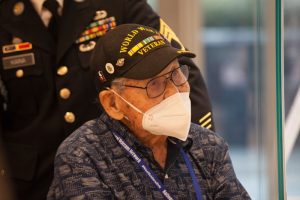
Ralph Matsumoto (Photo: Courtesy of NVN)
In the same news release, Ralph Matsumoto said, “I never thought a day or exhibit like this would happen in my lifetime. I am so grateful to everyone who made this exhibit a reality. I am grateful to the National Veterans Network for their commitment to telling our story.”
Joining the two couples were about 40 families of veterans of the 100th Battalion, the 442nd Regimental Combat Team and the MIS. Included in that cohort were families of Medal of Honor recipients Pfc. Kaoru Moto, 100th Infantry Battalion; Pfc. Sadao Munemori, 100th Infantry Battalion; and Pfc. George Sakato, 442nd Regimental Combat Team.
“Most of the veteran families had either an object or a story in the Nisei Soldier exhibit itself,” Sato-Yamazaki told the Pacific Citizen. “So, it was really about having these daughters and sons and family members, grandchildren come and see.
“For example, George Sakato, who’s a 442nd Medal of Honor recipient, Leslie, his daughter, came, and her father’s helmet that he wore during the war was on display. . . . It was very emotional, it was very inspiring.”
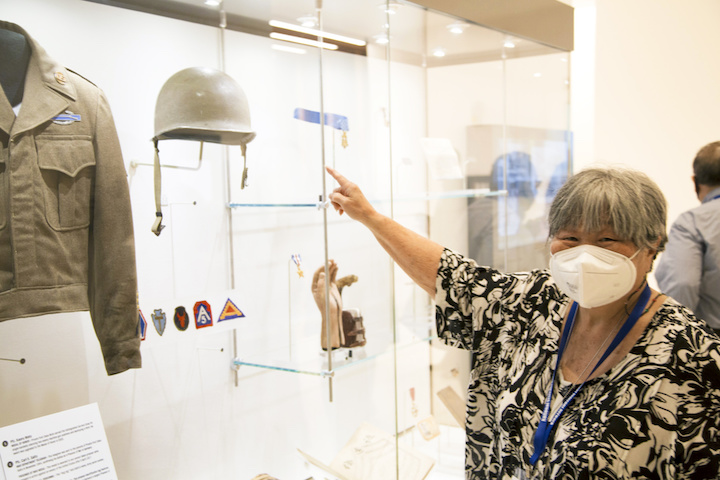
Leslie Sakato points out the helmet once worn by her father, George Sakato, a 442nd veteran who was awarded an upgraded Medal of Honor in 2000. (Photo: Courtesy of NVN)
The Nisei Soldier Experience will be on display at the NMUSA until January 2025. That this particular exhibition is included so prominently in the museum’s early programming is a testament to a case of preparation and hard work meeting opportunity that began years before the opening of the museum to ensure that the WWII contributions of the Nisei Army vets were included.
“We had gone and talked to the museum leadership about four years ago, and they did not actually know about the 100th and 4-4-2 and MIS. The historians did, but the museum leadership did not,” Sato-Yamazaki said.
“I think that, one, they were just surprised that they didn’t know this or learn the story. And they recognized that it was an American story, it was part of the 246-year history of the Army,” she continued. “So, to their credit, one of the things that we had done with them is they traveled with us for about a year to eight different Japanese American communities across the United States. And so, the director of their museum, Tammy Call, and then the former military curator, Dr. (Charles) Cureton, Gen. (Eric) Shinseki and I traveled to all eight cities. And we introduced the museum, and then we introduced the concept of incorporating the Nisei soldiers into the museum.”
According to Sato-Yamazaki, during the eight-city tour, they asked members of the respective Japanese American communities whether they had any objects that families would be willing to donate to the museum.
“At the time, the museum had zero Nisei objects,” she noted, adding that without objects, there was nothing around which to build an exhibition.
“As a result of the tour, they had hundreds of objects that were donated. And then from there, NVN took the lead to develop the stories around the objects,” Sato-Yamazaki said. Furthermore, she said the Nisei contribution to the Army and WWII is baked into the museum in several permanent ways, as well.
“The 100th/4-4-2 and MIS are actually incorporated in three other areas of the museum. It’s not talked about very much, but I think it’s important. There is a permanent exhibit in the Army in Society Gallery,” Sato-Yamazaki said. “And there’s space that’s dedicated to the Japanese American soldiers, World War II soldiers, and it’s in the context of Executive Order 9066. And just the overall contributions of the three units.
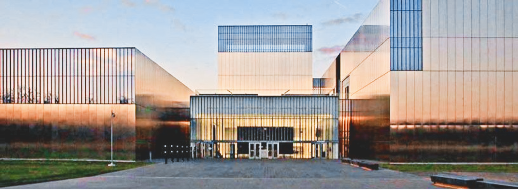
The National Museum of the United States Army is now open to the public, 9 a.m.-5 p.m. The Nisei Soldier Experience will continue through January 2025. (Photo: Courtesy of NMUSA)
“In that display case, Sadao Munemori’s Medal of Honor, his Purple Heart and his Gold Star pin are on display. And also, the senninbari worn by 442nd veteran Jimmy Mizote and a dictionary that was used by an MIS [soldier], so there’s like about 11 objects in there. That’s on permanent display.
“And then, in the Soldiers’ Stories Gallery, which is right when you enter the museum, there are these steel pylons. One is dedicated to Don Oka from Los Angeles. He served in the MIS.”
Sato-Yamazaki also related that there are also some digital pylons where visitors can swipe through different profiles — among them are profiles of 10 Nisei. Finally, among permanent exhibitions that include Nisei is the Medal of Honor experience, where the 21 members of the 100th/442nd who were awarded the Medal of Honor are memorialized. “So, the Niseis are actually in four areas of the museum,” she said.
Among the dignitaries and speakers who were present for the Nisei Soldier Experience were Army Chief of Staff Gen. James McConville; Commander, U.S. Cyber Command, and Director, National Security Agency/Chief, Central Security Service Gen. Paul Nakasone; retired Gen. Eric Shinseki; Erika Moritsugu, deputy assistant to President Joseph Biden and Rep. Mark Takano. Also present were JACL Executive Director David Inoue and former JACL Executive Director Floyd Mori.
To learn more about the National Museum of the United States Army, visit thenmusa.org/exhibit/nisei-soldier-experience/. The NMUSA is located at 1775 Liberty Dr., Fort Belvoir, VA 22060.
To learn more about the National Veterans Network, visit nationalveteransnetwork.com/.



